E-Commerce Case Study: How an App Company Grew Their Organic Revenue from 0 to €20.000 monthly
Key Points
Client Industry
Apps / Earn Money Online Niche
Website State
New project / Starting from scratch
Niche Competitiveness
Very competitive
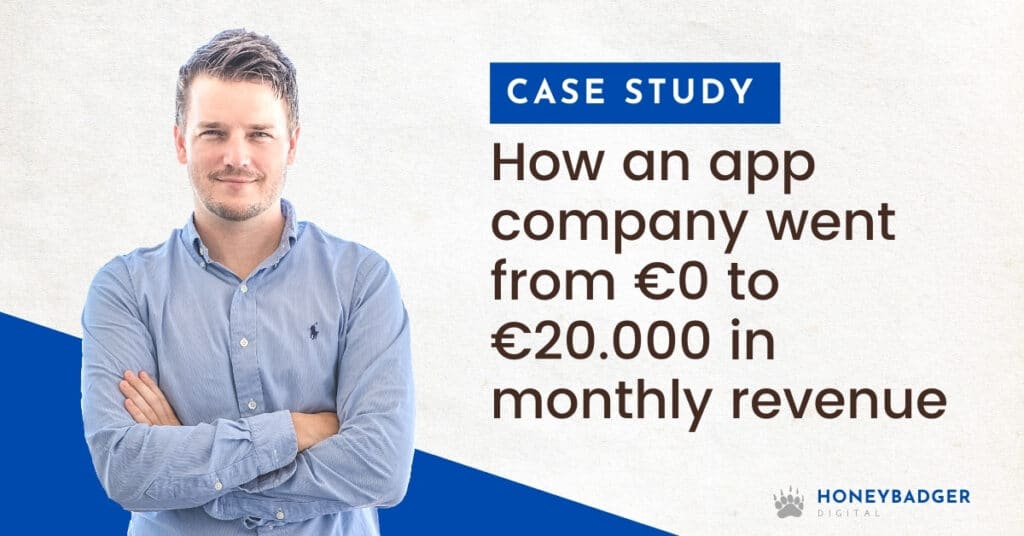
How does the idea of generating profit from unpaid, organic traffic on autopilot sound to you?
For one of our German clients, this has become a reality.
Within 15 months of working with us, they now generate around 20.000 euros per month in direct profit.
Everything runs on autopilot, and they receive around 45.000 relevant visitors per month. Compare that to Facebook Ads or Google AdWords, where you pay per click and lose everything the moment you stop paying.
Besides the instant and direct cash they generate through these website visitors, hundreds of organic users have installed their mobile phone app and have become recurring customers. Many even for years!
Pre-Project Status Quo
- We started working for them in November 2019.
- The goal was to gain relevant traffic that converts blog visitors into people who download and use their review app.
- The keywords targeted were in the “earn money” niche, and many of them are highly-competitive.
- Their website and domain had only been around for four months before we started. No SEO work had been done on the website and they received only minimal brand traffic.
- The client hired freelance writers and employed a developer who would assist us. He wanted to be kept up to date regularly, but wanted us to implement everything without taking up much of his time. We decided to set up a project manager and administer the entire SEO “supply chain.”
Before investing in SEO, the client received a majority of their traffic through Facebook and Youtube Ads. They wanted to stop being so dependent on these sources of traffic and approached us to grow their organic traffic.
In December 2019, they received around 5,000 visitors per month, many of them coming in via a brand search. They only ranked for three keywords in the top 1-3 positions in Google, as you can see from this data:
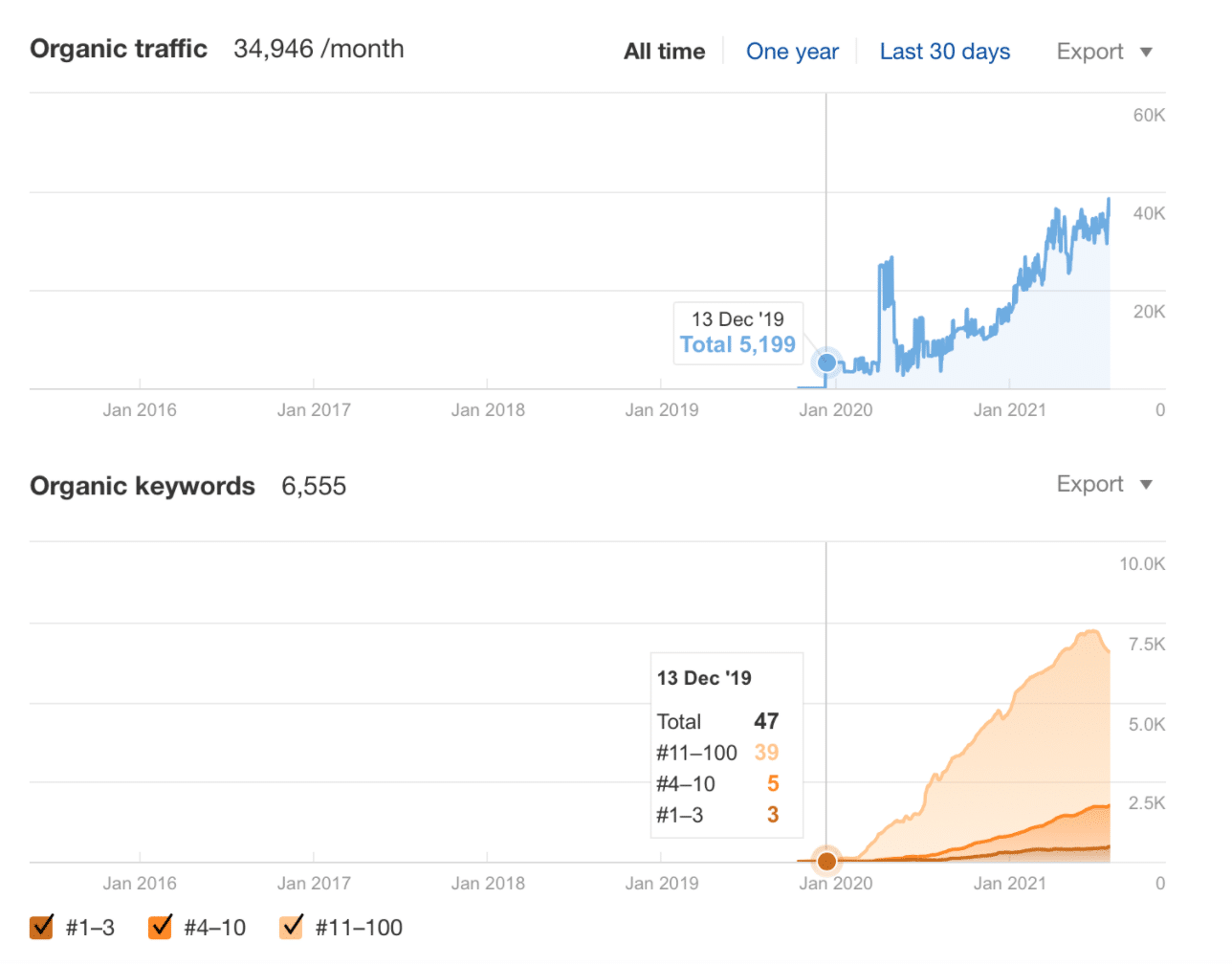
What We Did / Our SEO Strategy
It is important that any SEO project gets the initial analysis right before starting with the “treatment.” SEO is nearly as complex as the human body and medicine. In both cases, it pays to be examined by somebody who has analyzed hundreds and thousands of cases before. Our SEO strategy is structured as follows:
- Context Discussion
- Keyword Research & Competitor Analysis
- Technical SEO
- Content Brief Creation & Content Creation
- Link Building
These processes are all vital to achieve SEO results. Skip one, and chances are good that the project will fail. This is why we don’t do a la carte tasks for clients like “only link building.” Think of it like a car: you can have the best and strongest motor, but if the tires are run down, you might be in trouble.
Here is what we do in detail for each of these five processes:
1. Context Discussion
Before we start working on a project, we want to make sure that we know every single detail from the client that might be important to make the project successful. This is why we developed a structured interview process that enables us to truly understand our client’s needs and what we have to achieve those results for them.
It is a guided interview, so we have a chance to step in and tell our clients when we think that other goals or KPIs might make more sense for them to make more of a profit.
After the context interview is finished, we send the client a draft and ask them to approve it. This way, we make sure that we are both aligned and that we have laid the best foundation possible to work together positively and achieve the intended results.
2. Keyword Research & Competitor Analysis
In this case, the client stated that he would like to rank for all keywords in the “make money” umbrella in the German language. He also gave us a list of competitors that, in his estimation, already did a good job at ranking for these types of keywords.
We then ran a manual keyword research query and compiled an extensive list with around 100 keywords. Then we reengineered the competitors’ websites and looked for the keywords which ranked well. In the end, we compiled a long list of topically relevant keywords.
Since the “make money” niche keywords are rather competitive, it was important to be realistic and come up with a good prioritization for these keywords. The goal was to rank for the very difficult ones later and gain more immediate traction by focusing on keywords that:
- Were topically relevant
- Had a decent monthly search volume for Germany (everything above 150 searches per month)
- Had a low keyword difficulty (keywords that rather weak websites rank for)
This could look something like this:
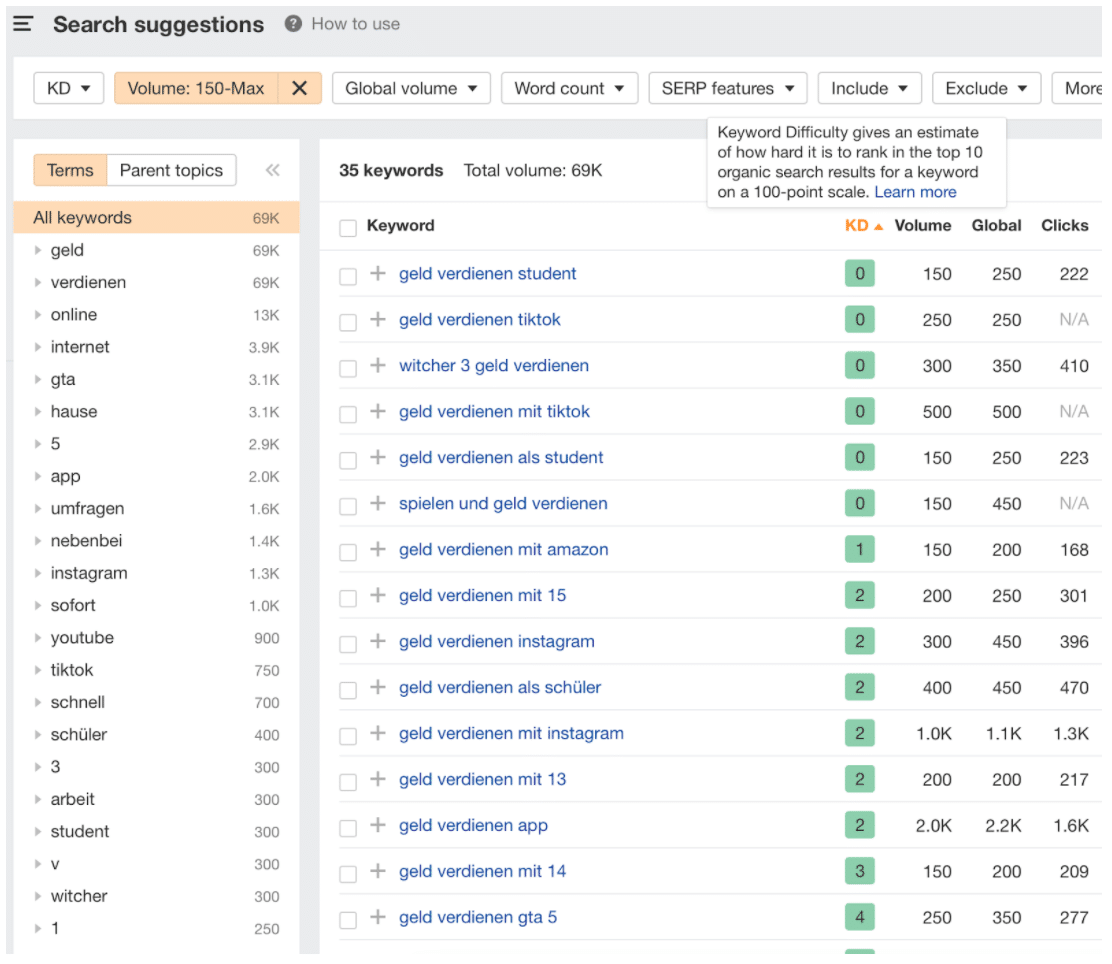
SEO is a lot like going to the gym. You don’t start out doing 200kg bench presses. Instead, you start with a weight that makes you grow slowly at first and that you can handle. By focusing on the low KD keywords (0 is the easiest on a scale from 0 to 100 in the Ahrefs SEO software), we had the best chance to get a new article indexed by Google and rank it well.
Besides looking at the keywords that the competitors were targeting, we also looked at other factors that made them rank successfully, for example:
- How many (high quality) backlinks did the site receive and from where?
- How is their website structured?
- Do they build innerlinks a certain way?
We then went ahead and included all of the perceived “winning factors” from various competitors into our client’s campaign.
3. Technical SEO
A website can have great content, but if it takes too much time to load on a mobile device, this will create a bad experience for the user. Google rewards good experiences, and it is very quick to give your website less organic traffic when it does not live up to its standards.
Here are the most common issues that lead to lower rankings when it comes to technical SEO:
- Slow loading time
- Website is not optimized for mobile phones
- There are spam links that point to your site
- Cannibalization (two pages compete for a single keyword and ultimately both lose)
- Thin content pages that do not add value to the user
- Over-optimized pages and blog posts (i.e. mentioning the target keyword too often and making the text unreadable)
- Innerlinking issues / broken links
- Wrong multi-language optimization (if you offer content in different languages)
Since this website was fairly new and didn’t have much content besides a handful of landing pages, there was no need to no-index large numbers of pages, as is often the case with more mature websites.
Their website speed was not ideal, so we gave the programmers some instructions to optimize this. We also made sure that pages that don’t need to appear in Google do not get indexed anymore. For example, pages like:
- Privacy Policy
- Terms of Service
- Contact Page
- About Us
The website was created in WordPress, but it did not have a blog yet. The creation and proper setup of a blog is important since we primarily focus on the blog to drive traffic to the website.
We also emphasized improving the E-A-T of the website. This stands for Expertise, Authority and Trust and is mainly addressed through adding a real author with real credentials in the niche.
Another major factor that Google looks at as they rank blog posts is proper design and UX so that the user does not get overwhelmed by what they see and bounce away (Google can measure this nowadays, and it results in a lower ranking).
This is what we did:
- Communicated the best blog practices to the developers and monitored the implementation process.
- Installed a plugin that automatically compresses the size of images when they are uploaded (this is important for the loading speed of a website and helps you rank better).
- Installed a Cache-Plugin, which pre-loads the website. This results in faster loading times, a better user experience and better rankings.
- Fixed broken links. Some links (for example, from news articles) were pointing to pages on the website that had been removed. That means that the links were not “counting” for Google anymore. Fixing this resulted in more link power for the website.
- Submitted an XML Sitemap in Google Search Console (this is the process where you send Google a map of your website so it can more easily crawl the pages).
- Checked Search Console for indexation problems (to see if there are quality issues).
- Created the ideal topical silo. This means that similar articles are put in the same directory which is innerlinked by breadcrumbs. This will result in better rankings for all keywords, not only the most valuable keywords (for example, “earn money”). In this case, it was: domain.com/earn-money/ (main keyword page) and domain.com/earn-money/with-youtube/ (long-tail keyword page).
4. Content Creation
If we go back to our car analogy, we have now made sure that the car is technically in order. Now, it is time to sit in the driver’s seat and start moving!
The biggest factor when it comes to SEO is usually content, followed by links. For this client, content creation was especially important because there was basically no content on the website when we started the project.
As a rule of thumb, you should rank for one keyword per page. For example, as you can see below, this website tries to rank for “best cat food” and includes it in the URL and the Title. Of course, you might also end up ranking for terms like “good cat food” naturally, but it would make no sense to keyword-stuff, for instance, to create an SEO Title that looks like this: “Best Cat Food – Best Cat Trees.”
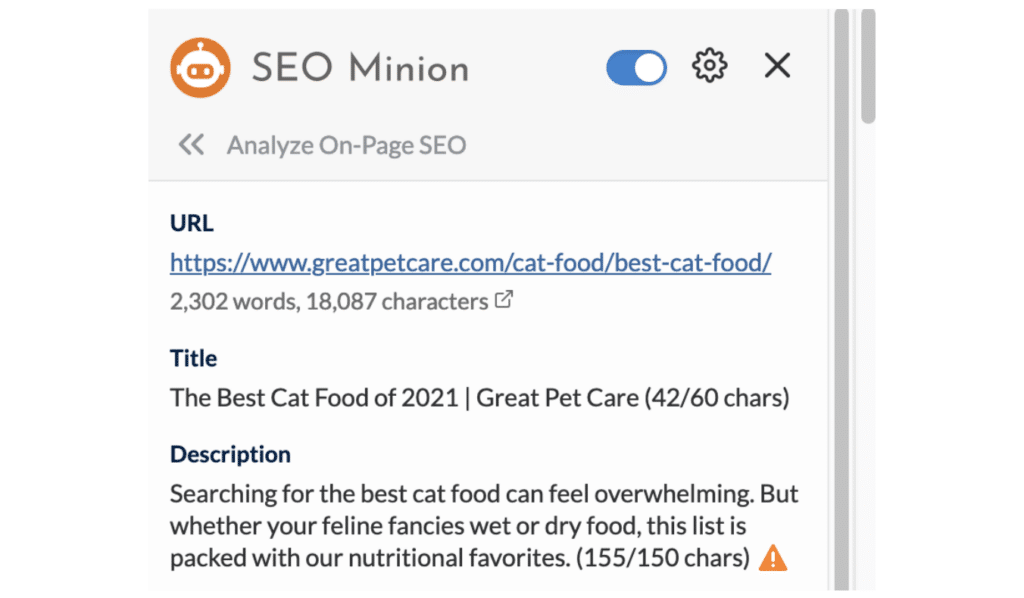
The client was motivated to move fast and provided an adequate budget for content, so we created 15 to 20 blog posts each month for them. The posts were all closely related and in the “make money” niche. That gave us many opportunities to interlink the articles.
For example, the article with the keywords “make money online” is linked to the article with the keywords “make money with YouTube.” Doing this helps pass so-called “link juice” between the articles (e.g. some ranking power is transferred from article A to article B when a backlink points back to article A). This technique also helps articles show up faster (index faster) in Google.
What did the content creation process look like?
- For this project, the client hired two high-quality writers on Upwork that we could brief and work with.
- We took the previously-researched keyword and put it into an SEO tool called SurferSEO. This software looks at the top-ranking pages for a certain keyword and gives you hints on what the winning strategies are. A big factor is the word count of a page or article. If you are too far out from what Google is ranking, often you don’t stand a chance to end up in the top search results even if you wrote the best article in the world.
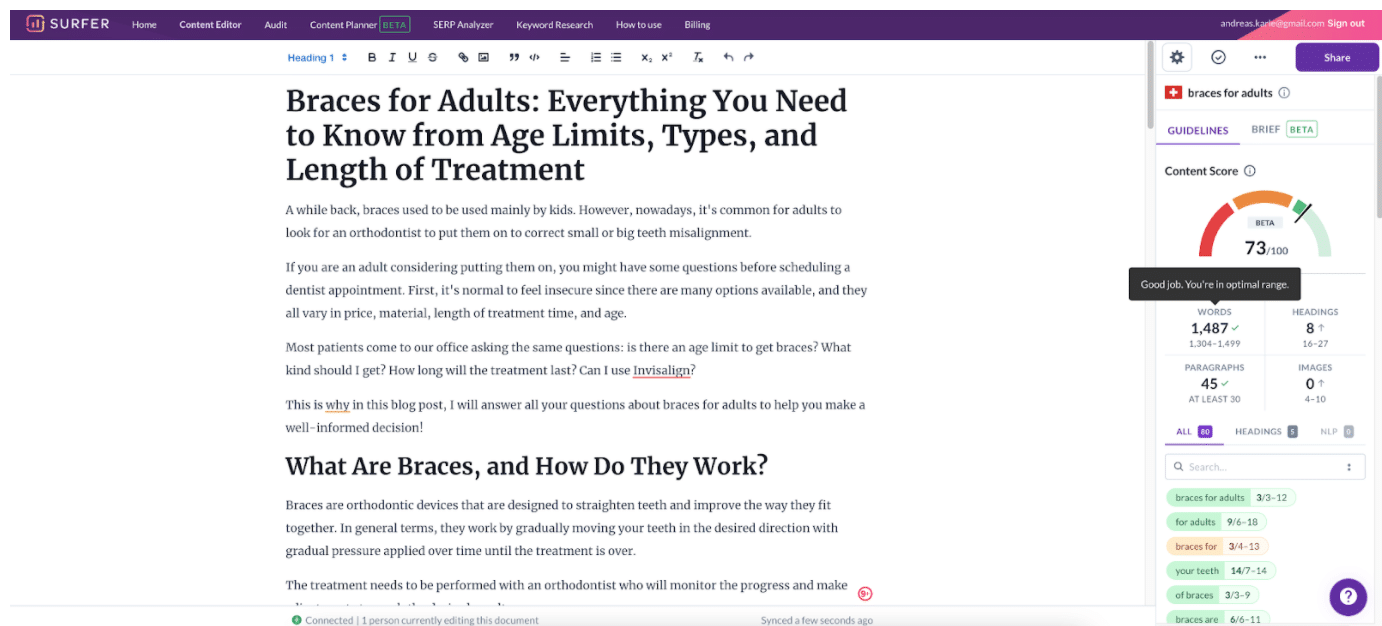
- We created the briefings in Surfer SEO (see example above) for every keyword. Then, the writer can type directly in the browser and see how many words are still missing until the optimal range of keywords for a specific keyword has been reached. For the above article, the optimal word count was between 1304 and 1499 words. We also gave the writers topic ideas taken from dozens of competitor blog posts so that we’d have a chance to cover all aspects of the topic and rank for as many keywords as possible.
- We sent the briefing to the writers, determined and monitored deadlines, and when finished, one of our content staff members uploaded and formatted the article in WordPress. The client’s goal was to be involved in this process as little as possible, so we handled all of the aspects of it ourselves.
As shown at the beginning of this case study, the website ranked for a total of 47 keywords in December 2019 when we started working on it. However, only three of those keywords were to be found in top three positions.
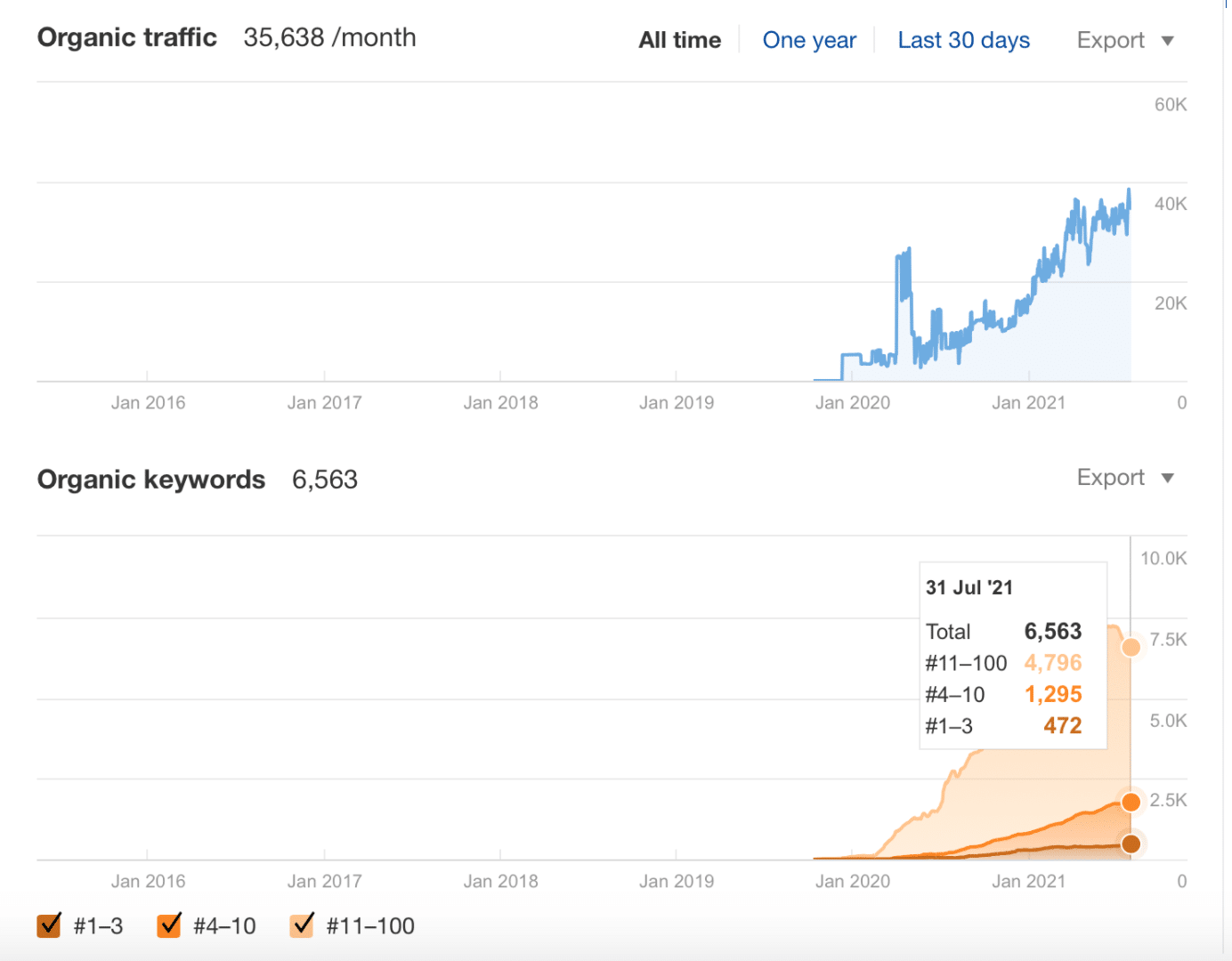
Around 1.5 years later, the website ranks for more than 6,500 keywords, and 472 keywords can be found in positions 1 to 3 in Google.
As you can see, the organic website traffic has gone up dramatically since we started working with them.
As always, with SEO, things take time. Like we mentioned in the beginning of this case study, it’s just like going to the gym. After a week, you probably don’t see much in the way of results, but after around three months, you can really see the proof of your efforts. That was also true here.
It is excellent if a keyword moves from position 100 to position 11 in Google. But you will only see the full potential of it once you move to the top 5 on the first page. That’s when the real party starts.
In this case, it took about five months for that to happen., Then, after approximately 12 months, we achieved solid and steady top positions for many more of their keywords.
5. Link Building
Since we dealt with a fairly new website that had just been registered, we created a brand new social footprint. That means we registered the site on as many business profiles and social platforms as possible. We also built custom social signals on platforms like Twitter, Quora and Facebook.
Our main goal was to make the website appear as authoritative as possible and gain trust with Google.
Our primary approach was to be conservative and build a fair number of brand links for our customer. One key way we do this is by including at least some of the brand name in the anchor text of the links. We also wanted to ensure that the homepage receives more backlinks than, for example, the blog. This is what Google expects, and we want to maintain that preferred ratio for our clients.
After a while, we shifted from building links on the homepage to the blog articles themselves. We used guest posts as the main link source for our client. At the same time, we wanted to make sure that we provided a diverse link profile that looks as natural as possible, which means including links that are so-called “nofollow” links – links that do not pass on ranking power but are important to appear natural.
On top of buying links from trusted, high-quality vendors, we also did manual outreach to interesting websites, because the best backlink a site can get is one that:
- Is from a page that is topically relevant (e.g. a cat blog that receives a backlink from another cat blog).
- Has many relevant backlinks themselves.
- Ranks highly in Google for the keyword(s) we want to rank for (this means that Google trusts the website a lot).
6. Results
After around 1.5 years of working on this project (April 2021), the traffic increased by 594% compared to where we started.
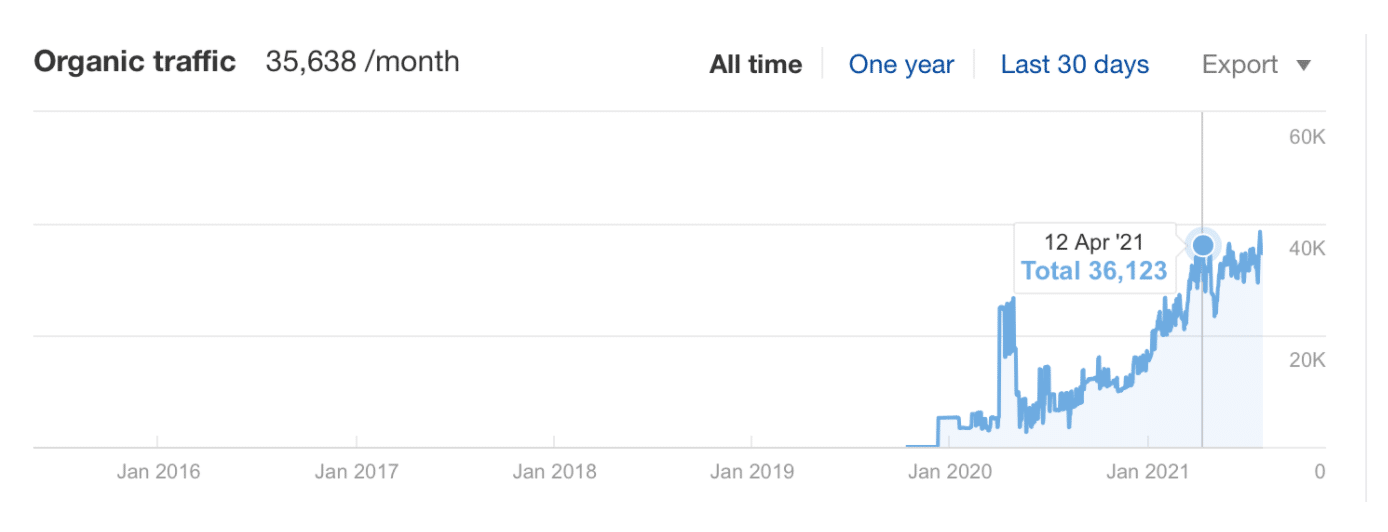
The client makes around €20.000 directly through the SEO traffic. They also receive around 350 app installs per month, which produces a lot of recurring purchases.
As you can imagine, the keywords in the “earn money” niche are very competitive. Usually, you need quite a fair number of high-quality backlinks and domain authority to rank for these terms. However, we were able to rank better than many competitors with only half the domain authority they have.
We were able to achieve this because we executed every step of the way – especially the content creation and innerlinking – better than our client’s competitors.
